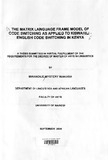| dc.contributor.author | Mwandije, Mystery W | |
| dc.date.accessioned | 2013-05-02T12:19:16Z | |
| dc.date.available | 2013-05-02T12:19:16Z | |
| dc.date.issued | 2004-09 | |
| dc.identifier.citation | Mwandinje, M.W.(2004).The matrix language frame model of code switching as applied to kiswahil i - English code switching in Kenya | en |
| dc.identifier.uri | http://erepository.uonbi.ac.ke:8080/xmlui/handle/123456789/18400 | |
| dc.description | MA(Linguistics) - Thesis | en |
| dc.description.abstract | Myers-Scotton (1993) came up with a theory of intrasentential code switching which
she named the "Matrix Language Frame Model" of code switching, and which she
suggested could work in analyzing code-switching data from any language. The aim of
this study was to check the extent to which the MLF Model would indeed work for data
involving code switching between Kiswahili and English in Kenya.
The study hypothesized that the key principles of the Matrix Language Frame
Model would help us determine which of the two languages involved in code-switching
was the Matrix language-that is, the dominant language, and which was the
embedded language-that is, the other language. The data used consisted of codeswitched
utterances from transcribed recordings of sections of a Kiss FM radio station
programme. On the one hand, code switching within these utterances was looked at
from the point of view of the MLF Model's principles and, on the other hand, a sample
of the same utterances was submitted to the judgments of a group of respondents,
who had to decide which of Kiswahili and English was the dominant language in the
data. Seeking the respondents' judgments was meant to check the psychological
validity of the model.
The findings of the study show that although there were cases where the principles
of the MLF Model did indeed work in accordance with the predictions made in Myers-
Scotton's exposition of the theory, there were others where the principles clashed and
thus did not enable the researcher to determine which the dominant language was.
Moreover, views from respondents were divided, and thus inconclusive once again in
terms of what the dominant language was.
The results of this study thus raise questions about the usefulness and
psychological validity of the MLF Model as applied to intrasentential code switching. | en |
| dc.description.sponsorship | University of Nairobi | en |
| dc.language.iso | en | en |
| dc.subject | Matrix language frame model | en |
| dc.subject | Code switching | en |
| dc.subject | Kiswahili-English code | en |
| dc.subject | Kenya | en |
| dc.title | The matrix language frame model of code switching as applied to kiswahil i - English code switching in Kenya | en |
| dc.type | Thesis | en |
| local.publisher | Department of Linguistic and African Languages, University of Nairobi | en |

